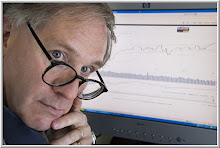 One of the indicators I track most carefully is the number of stocks across the NYSE, AMEX, and NASDAQ that are making fresh 20-day highs and lows. This is more sensitive than the more common count of 52-week new highs and lows. Above we have the 20-day new highs minus lows on a daily basis during 2007. There's been a distinct tendency for this measure to top out ahead of price during cyclical swings; extreme negative values have represented good buying opportunities.
One of the indicators I track most carefully is the number of stocks across the NYSE, AMEX, and NASDAQ that are making fresh 20-day highs and lows. This is more sensitive than the more common count of 52-week new highs and lows. Above we have the 20-day new highs minus lows on a daily basis during 2007. There's been a distinct tendency for this measure to top out ahead of price during cyclical swings; extreme negative values have represented good buying opportunities.As I noted in the Trading Psychology Weblog, we've had a surge in buying over the past two weeks, with the Adjusted NYSE TICK positive for 11 of the past 12 trading sessions. Over that same time, we've gone from a situation in which we've had over 1000 new 20-day lows to one in which we're now seeing more than 1000 new 20-day highs.
I went back to October, 2002 (N = 1279 trading days; which is when I began compiling data for 20-day new highs/lows) and examined situations in which we have surged from a surplus of new lows to one of new highs. Specifically, I looked for occasions in which the 20-day average of new lows has been above 1000, but the current day's reading of new highs has been over 1000. This captures a situation in which we've had a broad surge of strength following an oversold market.
There have been 32 instances of such surges in new highs since late 2002. Twenty days later, the S&P 500 Index (SPY) has averaged a gain of 1.90% (27 up, 5 down). That is much stronger than the average 20-day gain of .79% for the remainder of the sample (822 up, 425 down).
To be sure, there have been pullbacks along the way: 11 of the 32 instances were actually lower after five days. Nonetheless, broad surges in market strength have tended to be followed by further strength over the next month. On average, it's paid to use these pullbacks as buying opportunities.
RELATED POSTS:
What Happens After Short-Term Surges in New Highs
Stalking the Market With New Highs/Lows
Anticipating Market Turns With New Highs/Lows
.




